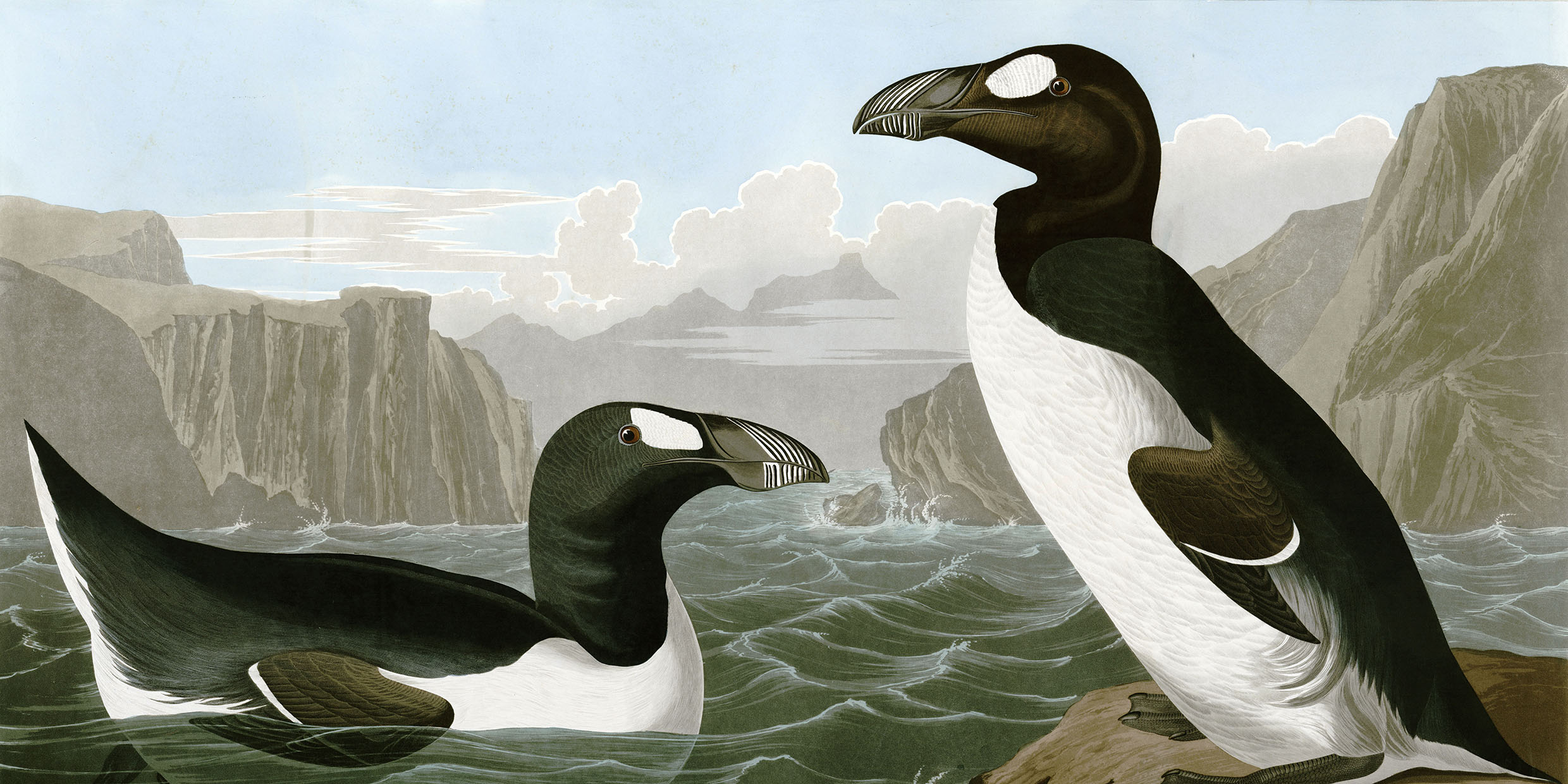Originally published 16 October 1989
This is the sad story of the great auk, a 2‑foot high flightless bird, the original “penguin,” now extinct. The events recounted here happened hundreds of years ago, but the great auk’s fate is a lesson for our time.
Older readers will recall a beast called the shmoo, invented by Al Capp in the comic strip Li’l Abner. The shmoo was a sweet, wobbly creature with the misfortune (or good fortune) of being almost totally consumable. Broiled shmoo tasted like steak; fried, like chicken. Shmoos gave eggs, butter, and Grade A milk. Their skin was a versatile fabric, the eyes made perfect suspender buttons, and even the whiskers served as toothpicks. Moreover, the cheerful, rapidly-reproducing shmoos willingly delivered themselves to human appetites; if you looked hungrily at a shmoo it dropped dead of sheer happiness.
The great auk was a real-life shmoo. Its eggs and flesh were delicious. The feathers made soft bedding. The carcass was rich with oil. In the sea the great auk was a powerful swimmer and diver, but on land it was as wobbly and defenseless as a shmoo. If it did not deliver itself cheerfully to the slaughter, it was nevertheless pathetically incapable of escape. An enterprising hunter with a club could decimate a colony of great auks in the course of an hour.
Until the 16th century, great auks populated the islands of the North Atlantic by the millions. For thousands of years they had been hunted by the native peoples of North America and Europe, but early predations had little effect on their numbers. Only when Europe embarked upon the Age of Technology was the great auk’s fate sealed.
The first Europeans to arrive on our shores found great auk rookeries from Labrador to Cape Cod crowded with masses of nesting birds, each pair incubating a single large egg. Journals of early explorers often describe effortless despoliation of great auk colonies. One seafarer noted the astonishing ease by which the birds were driven aboard ships, “as if God had made the innocency of so poor a creature to become such an admirable instrument for the sustenation of man.”
Rounded up by the hundreds
The great auk endured its persecutions with shmoo-like innocence. Birds were rounded up by the hundreds and skinned or boiled alive, or rendered for oil in great kettles fired by the carcasses of the birds themselves. The supply of birds seemed inexhaustible, and the plunderers never doubted that God had made the great auk for the increase and sustenance of men.
By the early 19th century, great auks were all but gone. John James Audubon possessed only one authentic record of a great auk on American shores, a bird caught on a fishing line by the brother of his engraver. Audubon’s 1834 painting of great auks depicts creatures so apparently benevolent and gentle it is hard to comprehend the magnitude of the avarice that drove the bird toward extinction.
The final and conclusive depredations of the bird were commissioned by “naturalists.” The great auk’s few remaining refuges were sought out by paid agents of individuals and institutions intent upon expanding their collections of avian skins and eggs — all, of course, in the name of science.
The last known surviving pair of birds were taken in June, 1844, on Eldey Rock, a precipitous island near the coast of Iceland, by agents of a collector. In the course of capture the pair’s solitary egg was smashed. Thus did great auks pass into extinction.
Animal extinction is not entirely a result of human avarice. Perhaps as many as 150,000 species of birds have existed during the past 140 million years, and 95 percent of those are now extinct. That works out to something like one extinction every 1000 years. As the saying goes, nature is red in tooth and claw.
The extinction rate soars
In the Era of Technology, nature has become significantly redder. Since the year 1600, about 75 known species of birds have been obliterated by human hand, an extinction rate several hundred times that of nature acting alone. Some biologists believe that in tropical regions of the world the extinctions for all flora and fauna may soon climb to 1,000 or 10,000 times the natural rate. The diminishment of biological diversity has become a central issue of our time.
Human dominion over the creatures of the Earth is absolute, but malevolence and exploitation are not the only causes of extinction. A more serious threat is habitat destruction resulting from expansion of human populations.
How many species will follow the great auk into extinction? Harvard biologist E. O. Wilson has written: “In the end, I suspect it will all come down to a decision of ethics — how we value the natural worlds in which we evolved and now, increasingly, how we regard our status as individuals.
And that’s the lesson of the great auk. Cartoonist Al Capp got it exactly right. “The shmoo is the greatest menace to humanity the world has ever known,” said Old Man Mose of the Valley of the Shmoon. “Thass becuz they is so bad, huh?” asked Li’l Abner. “No,” replied Old Man Mose. “It’s because they’re so good.”
By extinguishing the great auk — nature’s shmoo — we diminished ourselves. The great auk’s menace to humanity was its vulnerability.



